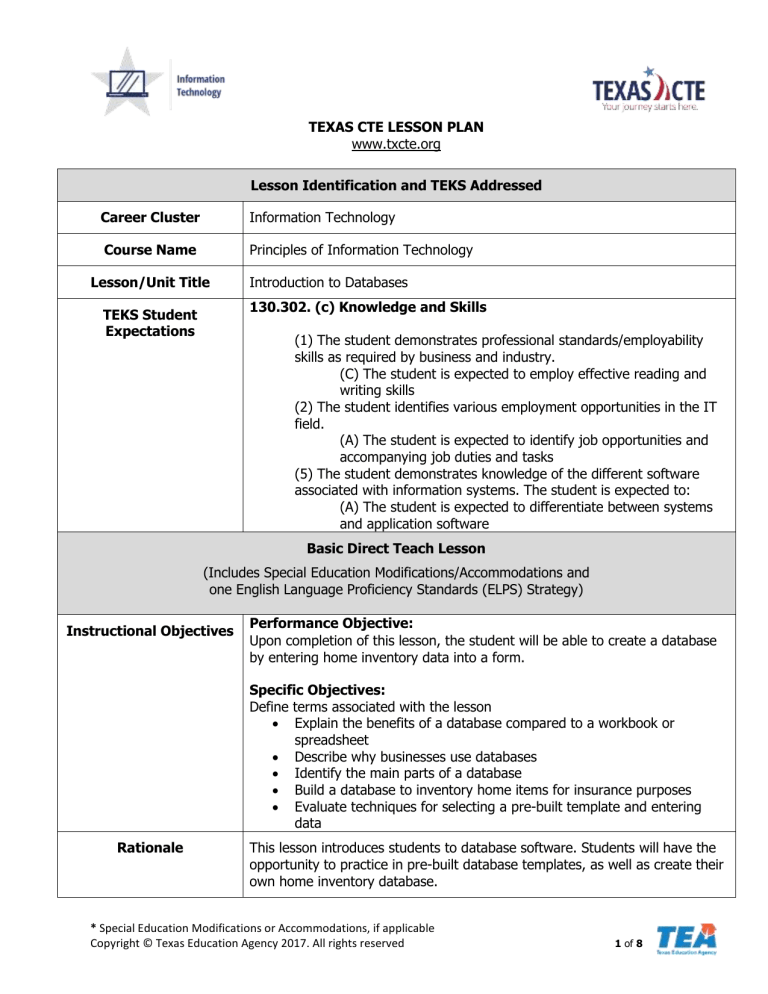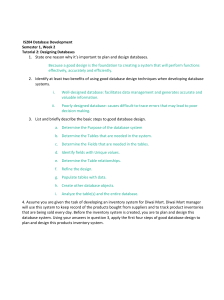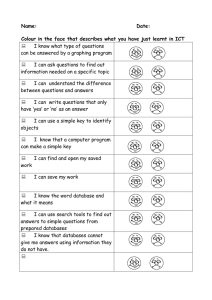
TEXAS CTE LESSON PLAN www.txcte.org Lesson Identification and TEKS Addressed Career Cluster Information Technology Course Name Principles of Information Technology Lesson/Unit Title Introduction to Databases 130.302. (c) Knowledge and Skills TEKS Student Expectations (1) The student demonstrates professional standards/employability skills as required by business and industry. (C) The student is expected to employ effective reading and writing skills (2) The student identifies various employment opportunities in the IT field. (A) The student is expected to identify job opportunities and accompanying job duties and tasks (5) The student demonstrates knowledge of the different software associated with information systems. The student is expected to: (A) The student is expected to differentiate between systems and application software Basic Direct Teach Lesson (Includes Special Education Modifications/Accommodations and one English Language Proficiency Standards (ELPS) Strategy) Instructional Objectives Performance Objective: Upon completion of this lesson, the student will be able to create a database by entering home inventory data into a form. Specific Objectives: Define terms associated with the lesson Explain the benefits of a database compared to a workbook or spreadsheet Describe why businesses use databases Identify the main parts of a database Build a database to inventory home items for insurance purposes Evaluate techniques for selecting a pre-built template and entering data Rationale This lesson introduces students to database software. Students will have the opportunity to practice in pre-built database templates, as well as create their own home inventory database. * Special Education Modifications or Accommodations, if applicable Copyright © Texas Education Agency 2017. All rights reserved 1 of 8 Duration of Lesson Word Wall/Key Vocabulary Teacher’s Discretion Refer Vocabulary Handout (ELPS c1a, c, f; c2b; c3a, b, d; c4c; c5b) PDAS II (5) Materials/Specialized Equipment Needed Instructional Aids: Introduction to Databases Vocabulary Handout Introduction to Databases Vocabulary Review Introduction to Databases Vocabulary Review (Key) Introduction to Databases Worksheet Introduction to Databases Worksheet (Key) Introduction to Databases Activities Home Inventory Database Evaluation Rubric Materials Needed: Database Software Instructional Aids Equipment Needed: Projector for Presentation Computer Lab Internet Access Anticipatory Set (May include preassessment for prior knowledge) ASK, “Did you know you have a very sophisticated database right inside your body?” SAY, “That’s right! It’s your amazing brain! In addition to maintaining your breathing, blood flow, body temperature, and other aspects that allow us to stay alive, it also constantly receives, sorts, and stores a vast amount of information, or data. This is also what databases do—it stores and organizes tons of data such as inventory, customer contacts, diet and exercise records, household expenses, etc.” SAY, “Today, we’ll be introduced to some database software, and we will learn when/why to use the software.” Direct Instruction * Outline Instructors can use the handouts, and note pages with the following outline. Be certain to review the “Introduction to Databases Activity Sheet” document before presenting the lesson. I. Instructor Notes If necessary, Instructors are recommended to make PowerPoint presentation in conjunction with the outline. Review the vocabulary terms previously given to the students. Define terms/concepts associated with the lesson * Special Education Modifications or Accommodations, if applicable Copyright © Texas Education Agency 2017. All rights reserved 2 of 8 a. Data - Bits or pieces of b. c. d. e. f. g. h. i. j. information. Database – A collection of data organized and cross-referenced for quick retrieval. Template – A pre-built database table formatted with categories such as those for business, education, and personal use including events, assets, inventory, and contacts. Table – The main function of a table in a database is to organize and store data. Tables are arranged in rows and columns making it easy to search, extract data from, and reference information. Related Table – A table that links or references information from another table, eliminating the need to duplicate data entry. Record – A group or set of related data. Field –The location for a piece of data or information. Form – Shows data for entry or review and is selected from one or more tables or queries. Query – A process for pulling data from tables for informational or reporting purposes. Report – Shows data for printing, display, or interaction and is * Special Education Modifications or Accommodations, if applicable Copyright © Texas Education Agency 2017. All rights reserved Students will complete the Introduction to Databases Vocabulary Review as part of the lesson summary. Demonstrate the main concepts within a database program. 3 of 8 II. III. selected from one or more tables Discuss the relevance of using databases a. Organization of vast amounts of data i. Discuss how overwhelming it would be to organize and keep track of employee information for a large retail corporation with 1.5 million employees. Explain the benefits of using a database as opposed to a workbook or spreadsheet. a. On the surface, both types of software seem similar. After all, they store data, and you can enter data in a grid of cells. b. The question is, “How do you want to organize your data”? c. Database software has a relational structure that helps keep large amounts of information accurate and provides you with customized manageable tables. Have the students complete the "Intro to Databases Outline Organizer" as you present the lesson. d. Spreadsheet software is used for analyzing numbers using formulas, while database software is used for the storage of large amounts of data that can be accessed easily and quickly. * Special Education Modifications or Accommodations, if applicable Copyright © Texas Education Agency 2017. All rights reserved 4 of 8 IV. V. Demonstrate selecting a template and entering data into the database. a. Demonstrate using the following tools/features (SEE GUIDED PRACTICE) i. Navigating to and opening the database software ii. Selecting and downloading a pre-built template from the database software package or the internet iii. Beginning a new database and entering data about an item in the classroom (a computer or projector is a good item) iv. Saving the new asset Explain Independent Practice Activity a. Students will brainstorm the fields needed to enter home inventory information for insurance purposes. (Ex. Item Name, Description, Model/Part Number, Estimated Purchase Price, etc.) b. Students will be responsible for “inventorying” at least * Special Education Modifications or Accommodations, if applicable Copyright © Texas Education Agency 2017. All rights reserved Review the “Independent Database Creation” instruction with the students (See “Introduction to Databases Activities”). Give each student a copy of the “Home Inventory Database Evaluation Rubric.” Review the rubric with the students. 5 of 8 25 items from their home. c. They will create their own database using the skills taught in this lesson to create a home inventory database. Guided Practice * Independent Practice/Laboratory Experience/Differentiat ed Activities * Lesson Closure The teacher will use database software and demonstrate how to select and download a pre-built template from the database software package or the internet. The students will enter and save a new asset choosing something from the classroom. Ask for one or two volunteers to re-demonstrate in front of peers. Encourage students watching to peer-coach and evaluate the student demonstrator on his or her techniques. Students will work on their personal home inventory databases independently. Q: What is data? A: Data is bits or pieces of information. Q: What is a database? A: A collection of data organized and cross-referenced for quick retrieval. . Q: Why is it important to use a database to organize data? A: Because it allows you to organize and make better informed decisions about vast amounts of data that is related but constantly changing. Q: What’s the difference between using spreadsheet software and using database software to organize data? A: Spreadsheet software is used for analyzing numbers using formulas, while database software is used to store large amounts of data. Introduction to Databases Vocabulary Review Activity Students will complete the fill-in-the-blank “Introduction to Databases Vocabulary Review” as a review of the lesson. Afterwards, the teacher will go through the worksheet with the class. Summative/End of Lesson Assessment * Informal Assessment Teacher will observe student demonstrators and observers during guided practice to assess student understanding of concepts and techniques. Revision/re-teach will occur as needed before moving to Independent Practice portion of the lesson. Teacher will circulate through the lab as students work independently to redirect/re-teach as necessary. * Special Education Modifications or Accommodations, if applicable Copyright © Texas Education Agency 2017. All rights reserved 6 of 8 Formal Assessment Teacher will use the Home Inventory Database Evaluation Rubric References/Resources/ Teacher Preparation Additional Required Components English Language Proficiency Standards (ELPS) Strategies College and Career Readiness Connection1 Recommended Strategies Reading Strategies Quotes Multimedia/Visual Strategy Presentation Slides + One Additional Technology Connection Graphic Organizers/Handout Writing Strategies Journal Entries + 1 Additional Writing Strategy Communication 90 Second Speech Topics Other Essential Lesson Components Enrichment Activity (e.g., homework assignment) Make this independent practice relevant and meaningful by explaining why home inventory is important. EX. Give the following scenario: If your house 1 Visit the Texas College and Career Readiness Standards at http://www.thecb.state.tx.us/collegereadiness/CRS.pdf, Texas Higher Education Coordinating Board (THECB), 2009. * Special Education Modifications or Accommodations, if applicable Copyright © Texas Education Agency 2017. All rights reserved 7 of 8 ever burned to the ground, the insurance company would need an inventory of the valuable items in your home to determine the replacement value. Family/Community Connection CTSO connection(s) SkillsUSA, Technology Student Association (TSA) Service Learning Projects Lesson Notes * Special Education Modifications or Accommodations, if applicable Copyright © Texas Education Agency 2017. All rights reserved 8 of 8



